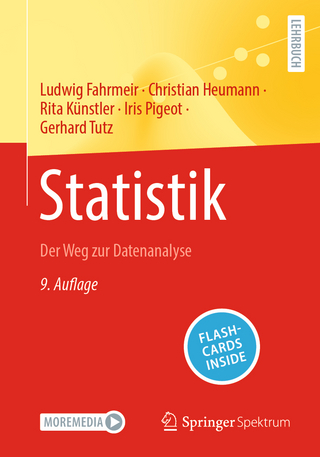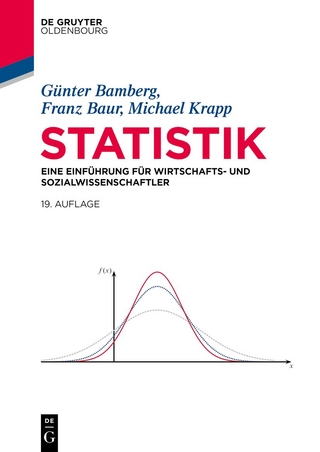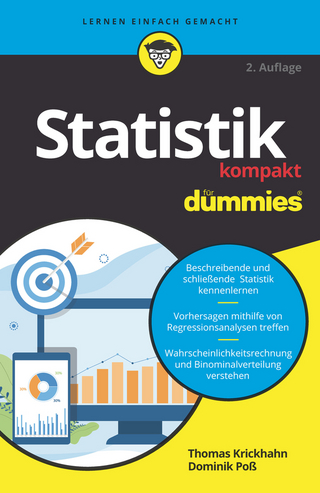
Statistical Analysis and Data Display
Springer-Verlag New York Inc.
978-1-4419-2320-2 (ISBN)
1 Introduction and Motivation.- 2 Data and Statistics.- 3 Statistics Concepts.- 4 Graphs.- 5 Introductory Inference.- 6 One-Way Analysis of Variance.- 7 Multiple Comparisons.- 8 Linear Regression by Least Squares.- 9 Multiple Regression—More Than One Predictor.- 10 Multiple Regression—Dummy Variables and Contrasts.- 11 Multiple Regression—Regression Diagnostics.- 12 Two-Way Analysis of Variance.- 13 Design of Experiments—Factorial Designs.- 14 Design of Experiments—Complex Designs.- 15 Bivariate Statistics—Discrete Data.- 16 Nonparametrics.- 17 Logistic Regression.- 18 Time Series Analysis.- A Software.- A.1 Statistical Software.- A.2 Text Editing Software.- A.2.1 Emacs.- A.2.2 Microsoft Word.- A.3 Word Processing Software.- A.3.2 Microsoft Word.- A.4 Graphics Display Software.- A.5 Operating Systems.- A.6 Mathematical Fonts.- A.7 Directory Structure.- A.7.1 HOME Directory.- A.7.2 HH Book Online Files.- B.1 Create Your Working Directory and Make the HH Library Available.- B.1.3 Windows and R.- B.1.6 Unix and R.- B.4 HH Library Functions.- B.5 Learning the S Language.- B.6 S Language Style.- C SAS.- C.1 Make the HH Library Available.- C.1.1 Windows.- C.1.2 Unix.- C.2 Using SAS with HH.- C.2.1 Reading HH Datasets.- C.2.2 Any Other Data Files.- C.2.3 ASCII Data Files with TAB Characters.- C.2.4 Windows and Unix EOL (End-of-Line) Conventions.- C.3 Macros.- C.4 Learning the SAS Language.- C.5 SAS Coding Conventions.- D Probability Distributions.- D.1.1 An Example Involving Calculations with the Binomial Distribution.- D.2 Noncentral Probability Distributions.- E Editors.- E.1 Working Style.- E.2 Typography.- E.3 Emacs and ESS.- E.3.1 ESS.- E.3.2 Mouse and Keyboard.- E.3.3 Learning Emacs.- E.3.4 Requirements.- E.4 Microsoft Word.- E.4.1 Learning Word.- E.4.2Requirements 6.- E.5 Microsoft Excel.- E.5.1 Database Management.- E.5.2 Organizing Calculations.- E.5.3 Excel as a Statistical Calculator.- E.6 Exhortations, Some of Which Are Writing Style.- E.6.1 Writing Style.- E.6.2 Programming Style and Common Errors.- E.6.3 Presentation of Results.- F Mathematics Preliminaries.- F.1 Algebra Review.- F.2 Elementary Differential Calculus.- F.3 An Application of Differential Calculus.- F.4 Topics in Matrix Algebra.- F.4.1 Elementary Operations.- F.4.2 Linear Independence.- F.4.3 Rank.- F.4.4 Quadratic Forms.- F.4.5 Orthogonal Transformations.- F.4.6 Orthogonal Basis.- F.4.8 Matrix Factorization—Cholesky.- F.4.9 Orthogonal Polynomials.- F.4.10 Projection Matrices.- F.4.11 Geometry ot Mlatrices.- F.4.12 Eigenvalues and Eigenvectors.- F.4.13 Singular Value Decomposition.- F.4.14 Generalized Inverse.- F.4.15 Solving Linear Equations.- F.5 Combinations and Permutations.- F.5.1 Factorial.- F.5.2 Permutations.- F.5.3 Combinations.- F.6 Exercises.- G Graphs Based on Cartesian Products.- G.1 Structured Sets of Graphs.- G.1.1 Cartesian Products.- G.1.2 Trellis Paradigm.- G.2 Scatterplot Matrices: splom and xysplom.- G.3 Cartesian Products of Sets of Functions.- G.4 Graphs Requiring Multiple Calls to xysplom.- G.5 Asymmetric Roles for the Row and Column Sets.- G.6 Rotated Plots.- G.7 Squared Residual Plots.- G.8 Alternate Presentations.- References.- List of Datasets.
| Erscheint lt. Verlag | 19.11.2010 |
|---|---|
| Reihe/Serie | Springer Texts in Statistics |
| Zusatzinfo | XXIV, 730 p. |
| Verlagsort | New York, NY |
| Sprache | englisch |
| Maße | 178 x 254 mm |
| Themenwelt | Mathematik / Informatik ► Mathematik ► Statistik |
| Mathematik / Informatik ► Mathematik ► Wahrscheinlichkeit / Kombinatorik | |
| ISBN-10 | 1-4419-2320-9 / 1441923209 |
| ISBN-13 | 978-1-4419-2320-2 / 9781441923202 |
| Zustand | Neuware |
| Informationen gemäß Produktsicherheitsverordnung (GPSR) | |
| Haben Sie eine Frage zum Produkt? |
aus dem Bereich


